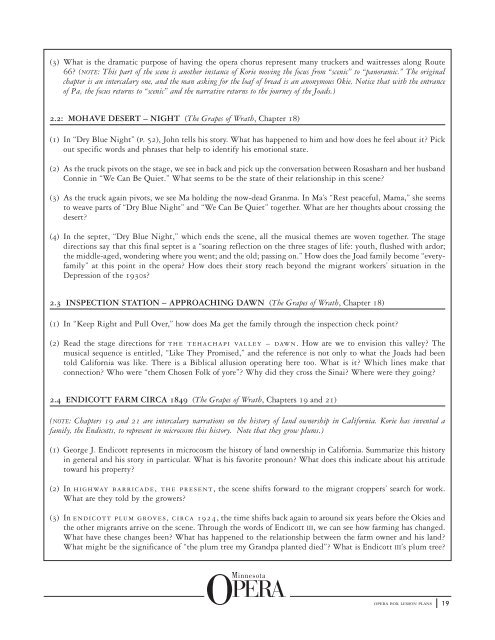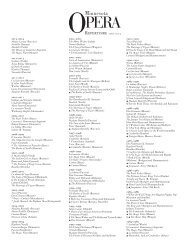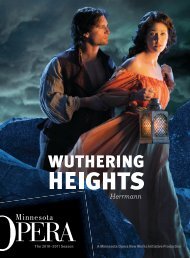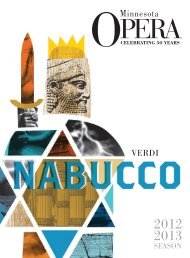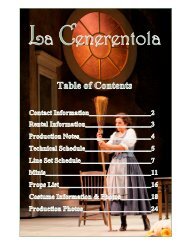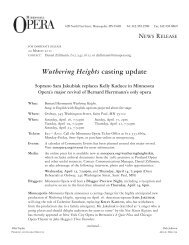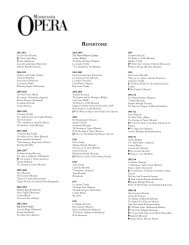You also want an ePaper? Increase the reach of your titles
YUMPU automatically turns print PDFs into web optimized ePapers that Google loves.
(3) What is the dramatic purpose of having the opera chorus represent many truckers and waitresses along Route<br />
66? (NOTE: This part of the scene is another instance of Korie moving the focus from “scenic” to “panoramic.” The original<br />
chapter is an intercalary one, and the man asking for the loaf of bread is an anonymous Okie. Notice that with the entrance<br />
of Pa, the focus returns to “scenic” and the narrative returns to the journey of the Joads.)<br />
2.2: MOHAVE DESERT – NIGHT (The <strong>Grapes</strong> of Wrath, Chapter 18)<br />
(1) In “Dry Blue Night” (p. 52), John tells his story. What has happened to him and how does he feel about it? Pick<br />
out specific words and phrases that help to identify his emotional state.<br />
(2) As the truck pivots on the stage, we see in back and pick up the conversation between Rosasharn and her husband<br />
Connie in “We Can Be Quiet.” What seems to be the state of their relationship in this scene?<br />
(3) As the truck again pivots, we see Ma holding the now-dead Granma. In Ma’s “Rest peaceful, Mama,” she seems<br />
to weave parts of “Dry Blue Night” and “We Can Be Quiet” together. What are her thoughts about crossing the<br />
desert?<br />
(4) In the septet, “Dry Blue Night,” which ends the scene, all the musical themes are woven together. The stage<br />
directions say that this final septet is a “soaring reflection on the three stages of life: youth, flushed with ardor;<br />
the middle-aged, wondering where you went; and the old; passing on.” How does the Joad family become “everyfamily”<br />
at this point in the opera? How does their story reach beyond the migrant workers’ situation in the<br />
Depression of the 1930s?<br />
2.3 INSPECTION STATION – APPROACHING DAWN (The <strong>Grapes</strong> of Wrath, Chapter 18)<br />
(1) In “Keep Right and Pull Over,” how does Ma get the family through the inspection check point?<br />
(2) Read the stage directions for the tehachapi valley – dawn. How are we to envision this valley? The<br />
musical sequence is entitled, “Like They Promised,” and the reference is not only to what the Joads had been<br />
told California was like. There is a Biblical allusion operating here too. What is it? Which lines make that<br />
connection? Who were “them Chosen Folk of yore”? Why did they cross the Sinai? Where were they going?<br />
2.4 ENDICOTT FARM CIRCA 1849 (The <strong>Grapes</strong> of Wrath, Chapters 19 and 21)<br />
(NOTE: Chapters 19 and 21 are intercalary narrations on the history of land ownership in California. Korie has invented a<br />
family, the Endicotts, to represent in microcosm this history. Note that they grow plums.)<br />
(1) George J. Endicott represents in microcosm the history of land ownership in California. Summarize this history<br />
in general and his story in particular. What is his favorite pronoun? What does this indicate about his attitude<br />
toward his property?<br />
(2) In highway barricade, the present, the scene shifts forward to the migrant croppers’ search for work.<br />
What are they told by the growers?<br />
(3) In endicott plum groves, circa 1924, the time shifts back again to around six years before the Okies and<br />
the other migrants arrive on the scene. Through the words of Endicott III, we can see how farming has changed.<br />
What have these changes been? What has happened to the relationship between the farm owner and his land?<br />
What might be the significance of “the plum tree my Grandpa planted died”? What is Endicott III’s plum tree?<br />
opera box lesson plans<br />
19


